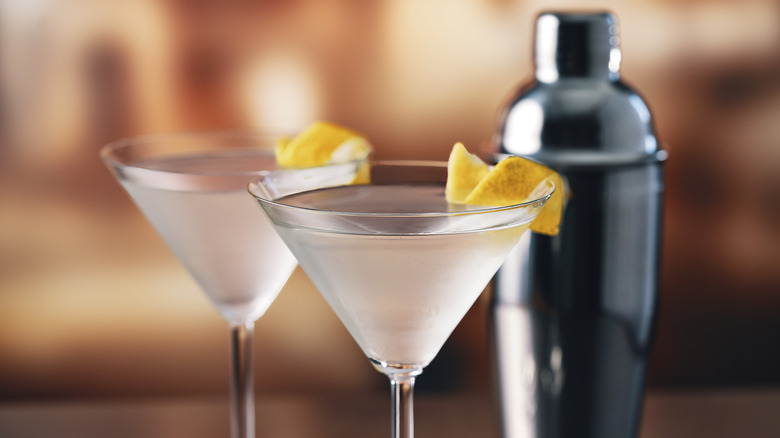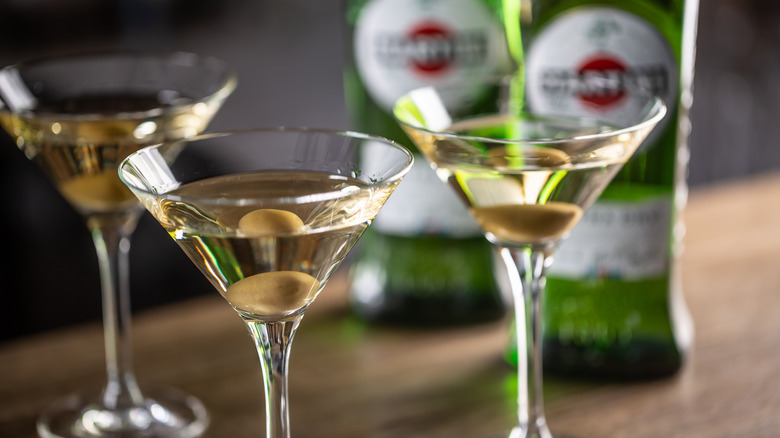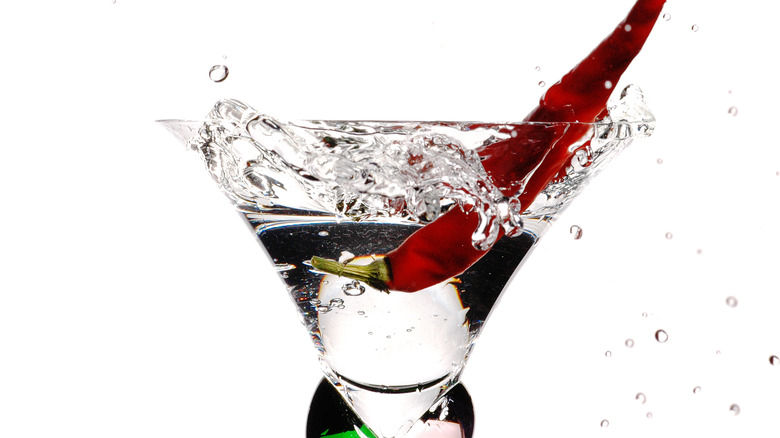What Does It Mean To Take A Martini Dry?
For such a simple, elegant cocktail, there are many contrasting opinions on the proper way to prepare a martini and an equal number of versions of the high-octane drink. Whether you've been influenced by James Bond's familiar request, "shaken, not stirred," or ask the bartender to throw your martini, you may wonder what it takes to make the drink "dry."
In the world of boozy beverages, sweet and dry (or wet and dry) are flavor profiles on opposite ends of the spectrum. Wine or spirits described as "dry" have a low or zero sugar content and lack sweetness. They have a strong taste, which is categorized as bitter and harsh. Unlike sweeter, fruity drinks that go down very easily, dry cocktails are meant to be sipped and slowly enjoyed.
While the origin of the martini is being debated, there's evidence that the modern-day cocktail is a less sweet, paired-down version of the 19th-century OG. Today, mixologists prepare martinis with gin or vodka and vermouth. Although vermouth is available "sweet" or "dry," a dry gin martini is typically made with a ratio of five parts gin to one part dry vermouth. If you want an "extra dry" martini, reduce the amount of vermouth to a scant ¼ of an ounce, but don't leave it out entirely since the lightly floral liquor is the only thing differentiating the martini from a glass of gin.
A little dry martini history
While they aren't for everyone, martinis have remained popular for centuries. Until the 1950s, gin was the traditional spirit used. During America's Prohibition era, those who couldn't smuggle liquor made bathtub gin, mixing it with an equal amount of vermouth to mask its unpleasant taste, known as a 50-50 dry martini. Since vermouth was primarily produced in Europe, WWII disrupted the distribution of fortified wine, but that didn't stop people from adapting the formula. As a result, the amount of vermouth in the recipe decreased, making martinis increasingly dry.
Over time, well-known figures and catchy nicknames introduced varying levels of dryness, like the Dickens martini, which doesn't have an olive or twist. American writer Ernest Hemingway popularized the Montgomery martini, named after British Field Marshal Bernard Montgomery, who was instrumental in the Allied victory during WWII. This martini is prepared with 2 ½ ounces of gin and ⅙ ounces of dry vermouth, or a 15:1 ratio (the same odds given to Montgomery on the battlefield).
The Churchill martini is named after the U.K.'s former prime minister, who reportedly liked his gin martini Sahara desert dry. He forbade vermouth to touch his glass but allowed it to be in the same room. Today, you may find "naked" or "direct" martinis on cocktail menus created at Duke's Hotel in London. Vermouth is swirled inside a chilled glass, lightly coating the inside, then dumped out and replaced with gin or vodka.
Variations on a classic dry martini
With the unlimited availability of ingredients and inspiration from social media, bartenders and home mixologists have gotten creative with the classic martini recipe. While everyone agrees a martini should be frosty and cold, there are exciting ways to shake up the elegant cocktail while staying true to its dry palate.
Similar to dry vermouth, Lillet Blanc is substituted to prepare a smoother cocktail with a less astringent bite. It's particularly nice in vodka martinis, which lack the herbaceousness of gin. Made with Sémillon and Sauvignon Blanc grapes, this French apéritif is only slightly sweeter than dry vermouth, with hints of orange, honey, and vanilla. It's used in James Bond's signature drink, a Vesper martini, containing gin, vodka, Lillet Blanc, and lemon peel.
Keeping with the same ratio of gin or vodka to dry vermouth, prepare a dirty martini by adding a splash of olive brine. Add more brine, and it turns from dirty to downright filthy. Variations on this salty drink include swapping pickle brine for the olive or using an infused vodka, like Stoli's Old Bay or Absolute's Peppar, to add spice. And for those who want something spicy, New Orleans is credited with the Cajun martini, which uses a jalapeño-infused vodka to keep you sweating in case the Big Easy's humidity doesn't do the trick.



